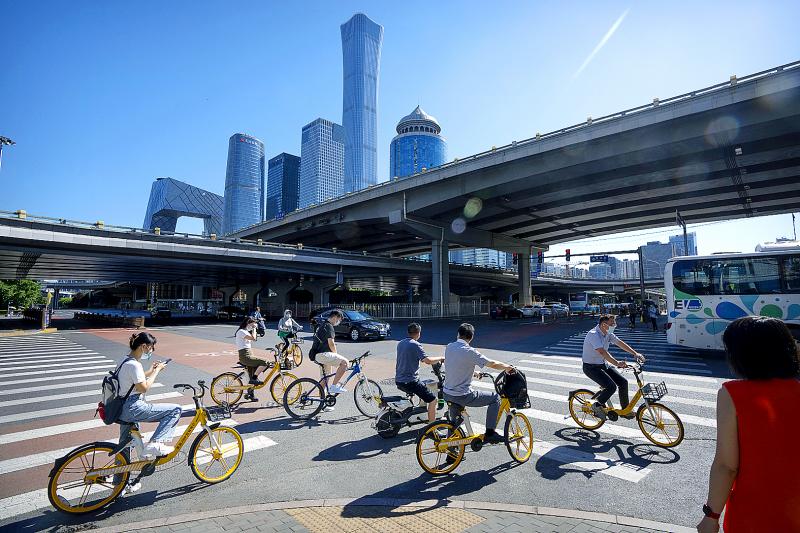The IMF urged China to accelerate its COVID-19 vaccination program, warning that the sharply slowing pace of new doses administered could undermine a recovery in domestic consumer spending.
At the current pace, providing three doses of COVID-19 vaccines to the population would take a “matter of years,” Helge Berger, head of the IMF’s China mission, said in an interview.
With spending growth yet to recover to pre-pandemic rates, partly because households are cautious about COVID-19 infections, “an acceleration of the vaccination campaign would support confidence and ultimately consumption,” he said.

Photo: AP
About 375 million people over the age of 15 in China have yet to receive three doses of a vaccine, while the daily vaccination rate has fallen below 800,000 per day, official data show.
Studies have shown that three doses of China’s domestic COVID-19 vaccines were nearly as effective as mRNA vaccines in preventing severe infections or deaths.
The low rate of full vaccination, particularly among elderly people, is one of the reasons China is persisting with its strict “zero COVID” policy requiring limits on activity wherever virus cases occur.
Only about 64 percent of Chinese people over 60 have received three doses, the Chinese National Health Commission said.
Berger said the lockdowns in Shanghai and dozens of other cities since March are a key reason the IMF sees “downside risks” to its April forecast of 4.4 percent GDP growth for China this year.
“The second quarter will be weak given the lockdowns,” he said.
While national data have largely returned to pre-lockdown levels, Berger added that in Shanghai, measures of economic activity monitored by the IMF have recovered only to about 50 percent.
Economists surveyed by Bloomberg predict growth of 4.1 percent in China this year and a possible contraction in quarter-on-quarter GDP in the April-June period. That makes it unlikely the government would meet its full-year target of about 5.5 percent.
The IMF has consistently called on Beijing to increase fiscal support to households. Even taking into account measures announced since April, China’s fiscal stimulus this year is smaller relative to 2020, Berger added.
“The known fiscal measures this year are still small relative to 2020, even taking into account that in 2020 the overall shock was larger than this year,” he said.

CHIP RACE: Three years of overbroad export controls drove foreign competitors to pursue their own AI chips, and ‘cost US taxpayers billions of dollars,’ Nvidia said China has figured out the US strategy for allowing it to buy Nvidia Corp’s H200s and is rejecting the artificial intelligence (AI) chip in favor of domestically developed semiconductors, White House AI adviser David Sacks said, citing news reports. US President Donald Trump on Monday said that he would allow shipments of Nvidia’s H200 chips to China, part of an administration effort backed by Sacks to challenge Chinese tech champions such as Huawei Technologies Co (華為) by bringing US competition to their home market. On Friday, Sacks signaled that he was uncertain about whether that approach would work. “They’re rejecting our chips,” Sacks

NATIONAL SECURITY: Intel’s testing of ACM tools despite US government control ‘highlights egregious gaps in US technology protection policies,’ a former official said Chipmaker Intel Corp has tested chipmaking tools this year from a toolmaker with deep roots in China and two overseas units that were targeted by US sanctions, according to two sources with direct knowledge of the matter. Intel, which fended off calls for its CEO’s resignation from US President Donald Trump in August over his alleged ties to China, got the tools from ACM Research Inc, a Fremont, California-based producer of chipmaking equipment. Two of ACM’s units, based in Shanghai and South Korea, were among a number of firms barred last year from receiving US technology over claims they have

BARRIERS: Gudeng’s chairman said it was unlikely that the US could replicate Taiwan’s science parks in Arizona, given its strict immigration policies and cultural differences Gudeng Precision Industrial Co (家登), which supplies wafer pods to the world’s major semiconductor firms, yesterday said it is in no rush to set up production in the US due to high costs. The company supplies its customers through a warehouse in Arizona jointly operated by TSS Holdings Ltd (德鑫控股), a joint holding of Gudeng and 17 Taiwanese firms in the semiconductor supply chain, including specialty plastic compounds producer Nytex Composites Co (耐特) and automated material handling system supplier Symtek Automation Asia Co (迅得). While the company has long been exploring the feasibility of setting up production in the US to address

OPTION: Uber said it could provide higher pay for batch trips, if incentives for batching is not removed entirely, as the latter would force it to pass on the costs to consumers Uber Technologies Inc yesterday warned that proposed restrictions on batching orders and minimum wages could prompt a NT$20 delivery fee increase in Taiwan, as lower efficiency would drive up costs. Uber CEO Dara Khosrowshahi made the remarks yesterday during his visit to Taiwan. He is on a multileg trip to the region, which includes stops in South Korea and Japan. His visit coincided the release last month of the Ministry of Labor’s draft bill on the delivery sector, which aims to safeguard delivery workers’ rights and improve their welfare. The ministry set the minimum pay for local food delivery drivers at